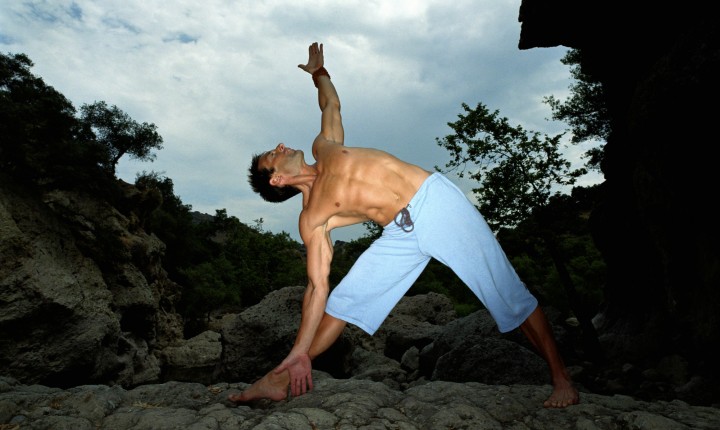Regular exercisers tend to have set routines. After a few weeks in the gym, they know what they’re doing and when: They know when they’re hitting the weight room, what body parts will be worked, and how many reps and sets they’ll perform. They get in a groove and they start to see results so they continue that same routine week after week. Habits and routines are great, but what if I told you there’s one thing that most exercises neglect to fit into their regimens—and that adding it could make you stronger?

Yoga. For those who lift, yoga (or stretching in general) can be an easy way to ensure tight or overworked muscles get the attention they need. Although we tend to think of ourselves as perfectly balanced machines, most of us focus more on certain body parts when working out. Sometimes this is due to aesthetic goals and wanting a certain area of our body to look a certain way. Other times, inadequate knowledge of how to train our bodies evenly is at fault. Moreover, typical weight lifting movements (bench press, squats, deadlifts) have people moving in a short range single plane of motion. When we exercise this way, whether knowingly or not, we create muscular imbalances. In turn, these imbalances cause muscle weaknesses or tightness throughout our bodies.
Yoga can help reduce stiffness from tight or shortened muscles, help balance opposing muscle groups, and even help you gain strength in weak areas.
For example, weight lifters who focus on their chest and anterior deltoids (upper front of the body) sometimes have a weak back. Someone who focuses on developing large, strong quads can have significantly less strong (and usually tight) hamstrings. So what can yoga do for these imbalances?
Yoga can help reduce stiffness from tight or shortened muscles, help balance opposing muscle groups, and even help you gain strength in weak areas. This balance and increased flexibility flows well into your lifting routine. Here’s how:
 Increased flexibility and range of motion. This means you can get lower in your squats (and deadlift, sumo, snatch, and clean stances). Not only that, when your body parts are moving in their full range, you can safely push and hold things up over your head (overhead squats, barbell press, etc.) without the fear of hurting your shoulders. When you assume these correct postures and positions during lifting and use the full range of the muscle, your body can actually recruit more muscle motor units (and hence, more muscle fibers) to help with the lift. The more motor units you have helping in the lift, row, push, or press means you are building stronger muscles and eventually bigger muscles too (if you’re into that kind of thing). As an added bonus, the more motor units you use, the less you perceive your effort to be. This means more advanced and heavier exercises feel easier and thus the pattern of training heaver and getting stronger starts all over again.
Increased flexibility and range of motion. This means you can get lower in your squats (and deadlift, sumo, snatch, and clean stances). Not only that, when your body parts are moving in their full range, you can safely push and hold things up over your head (overhead squats, barbell press, etc.) without the fear of hurting your shoulders. When you assume these correct postures and positions during lifting and use the full range of the muscle, your body can actually recruit more muscle motor units (and hence, more muscle fibers) to help with the lift. The more motor units you have helping in the lift, row, push, or press means you are building stronger muscles and eventually bigger muscles too (if you’re into that kind of thing). As an added bonus, the more motor units you use, the less you perceive your effort to be. This means more advanced and heavier exercises feel easier and thus the pattern of training heaver and getting stronger starts all over again.
- Increased lubrication of joints, ligaments, and tendons. Simply put, the more your joints bend, the more synovial fluid (the body’s natural lubricant) flows through them, allowing your body to move more freely and without pain. “Yoga’s extreme range of motion (opposed to the range used in weight lifting or other exercise such as biking or running where joints are moving, but in a more limited way) sends fluid into the obscure corners and crevices of each joint,” says Loren Fishman, a physician at Columbia University specializing in rehabilitation medicine. This translates into easy, pain-free movement both on the yoga mat and in the weight room.
- Pain reduction. I don’t know many weight lifters who are pain-free 100 percent of the time. In reality, most of us, no matter our chosen sport or exercise, have minor aches and pains on a routine basis. Some of this is age, but some is from slight misalignment of joints or bones and then some is caused directly by unbalanced opposing muscle groups and tight muscles. Since yoga focuses on all major joints in the body as well as core strength and spinal flexibility, many people find that practicing it can help an achy body and even greatly reduce chronic pain around these areas.
- Improved grip strength. While this might not be the most important benefit from adding yoga to your workout calendar, it should get your attention. It’s a shame when the first thing to give out in a lift is your grip, so why not give it a boost too?
Take your workout outdoors!
All these benefits lead to a more “well oiled” body and less injury in the long run.
if you can commit even 10 minutes per day, your muscles will thank you
I’m not implying that you need to attend 90-minute yoga sessions several times a week (do people really stretch for that long in one day?!), but if you can commit even 10 minutes per day (yes, every day, even the days you don’t work out), your muscles will thank you…and I’d even bet you’ll be feeling stronger and healthier than you have in a long while.
Related Posts
One Response to Yoga for a Stronger Body
Leave a Reply
You must be logged in to post a comment.
« Is Your Child’s Health Being Affected by Technology? 30 Minute Gladiator Workout: Traps and Forearms »













[…] Check out Strong Body SA‘s latest article about how to include yoga in your daily exercise routine as well as the many benefits yoga has on your body in Modern Gladiator magazine! […]